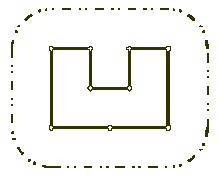![]()

墙:有个愚蠢的皇帝要你造墙将城堡围起来,城堡的顶点有N个,墙必须离城堡的边至少L单位远,并且墙的总长度尽量小。求此长度?
3.6与平面和空间打交道的计算几何
凸包
因为墙的长度要尽量短,所以墙不能凹进去。如图,最终的墙类似虚线部分,由凸包的周长和一个半径L的圆构成,于是求出凸包就搞定了。另外,题目阉割了英寸转换,用中文注明了“结果四舍五入就可以了”,估计要坑死一堆歪果仁。
#include <iostream>
#include <vector>
#include <algorithm>
#include <cmath>
using namespace std;
#define MAX_N 1000 + 16
#define M_PI 3.14159265358979323846
typedef int type_xy;
struct P
{
type_xy x, y;
P() {}
P(type_xy x, type_xy y) : x(x), y(y) {}
P operator + (P p){ return P(x + p.x, y + p.y); }
P operator - (P p){ return P(x - p.x, y - p.y); }
P operator * (type_xy d){ return P(x*d, y*d); }
bool operator < (const P& a) const
{
if (x != a.x) return x < a.x;
else return y < a.y;
}
type_xy dot(P p) { return x*p.x + y*p.y; }
type_xy det(P p) { return x*p.y - y*p.x; }
};
// 字典序比较
bool cmp_x(P a, P b)
{
if (a.x != b.x) return a.x < b.x;
return a.y < b.y;
}
// 求凸包
vector<P> convex_hull(P *ps, int n)
{
sort(ps, ps + n, cmp_x);
int k = 0; // 凸包的顶点数
vector<P> qs(n * 2); // 构造中的凸包
// 构造凸包的下侧
for (int i = 0; i < n; ++i)
{
while (k > 1 && (qs[k - 1] - qs[k - 2]).det(ps[i] - qs[k - 1]) <= 0) --k;
qs[k++] = ps[i];
}
// 构造凸包的上侧
for (int i = n - 2, t = k; i >= 0; --i)
{
while (k > t && (qs[k - 1] - qs[k - 2]).det(ps[i] - qs[k - 1]) <= 0) --k;
qs[k++] = ps[i];
}
qs.resize(k - 1);
return qs;
}
// 距离的平方
double dist(P p, P q)
{
return sqrt((double)(p - q).dot(p - q));
}
// 求解凸包对踵点最大距离
double max_distance(P *ps, int N)
{
vector<P> qs = convex_hull(ps, N);
int n = qs.size();
if (n == 2)
{
return dist(qs[0], qs[1]); // 特别处理凸包退化的情况
}
int i = 0, j = 0; // 某个方向上的对踵点对
// 求出x轴方向上的对踵点对
for (int k = 0; k < n; k++)
{
if (!cmp_x(qs[i], qs[k])) i = k;
if (cmp_x(qs[j], qs[k])) j = k;
}
double res = 0;
int si = i, sj = j;
while (i != sj || j != si) // 将方向逐步旋转180度
{
res = max(res, dist(qs[i], qs[j]));
// 判断先转到边i-(i+1)的法线方向还是边j-(j+1)的法线方向
if ((qs[(i + 1) % n] - qs[i]).det(qs[(j + 1) % n] - qs[j]) < 0)
{
i = (i + 1) % n; // 先转到边i-(i+1)的法线方向
}
else
{
j = (j + 1) % n; // 先转到边j-(j+1)的法线方向
}
}
return res;
}
// 求解凸包周长
double total_distance(P *ps, int N)
{
vector<P> qs = convex_hull(ps, N);
int n = qs.size();
double res = 0;
for (int i = 0; i < n; ++i)
{
res += dist(qs[i], qs[(i + 1) % n]);
}
return res;
}
P ps[MAX_N];
///////////////////////////SubMain//////////////////////////////////
int main(int argc, char *argv[])
{
#ifndef ONLINE_JUDGE
freopen("in.txt", "r", stdin);
freopen("out.txt", "w", stdout);
#endif
int N, L;
while (~scanf("%d%d", &N, &L))
{
for (int i = 0; i < N; ++i)
{
scanf("%d%d", &ps[i].x, &ps[i].y);
}
double ans = (2 * M_PI * L + total_distance(ps, N));
printf("%.0lf\n", ans);
}
#ifndef ONLINE_JUDGE
fclose(stdin);
fclose(stdout);
system("out.txt");
#endif
return 0;
}
///////////////////////////End Sub//////////////////////////////////
| 13897358 | hankcs | 1113 | Accepted | 236K | 63MS | C++ | 2819B | 2015-02-18 01:57:34 |
 码农场
码农场